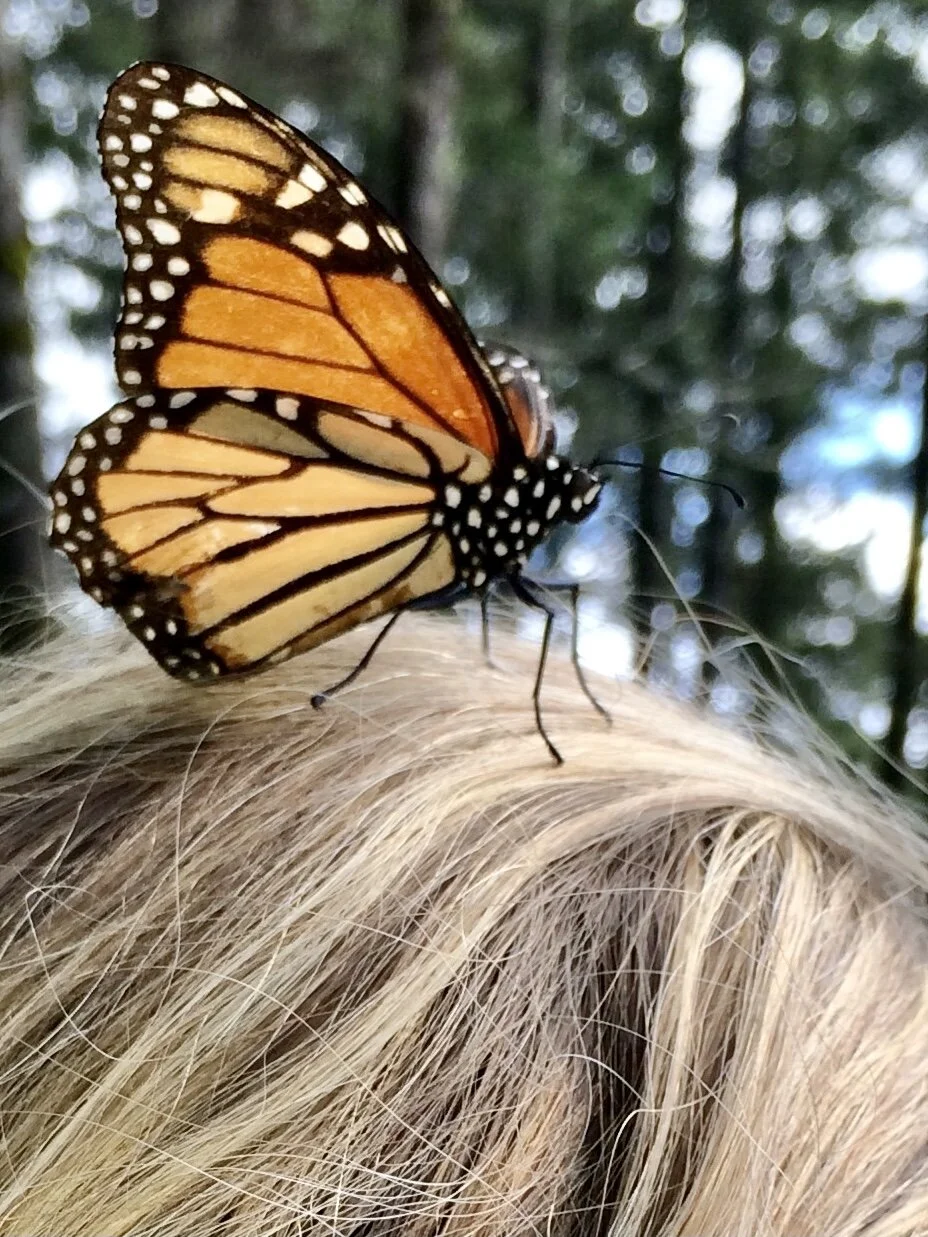20’ more of rebar.
I used 20’ more of rebar today to build the hip bones up on both sides and his right side in the stomach area of his side. I worked from the hip to his shoulder.
My work space is not large enough to get a good side photo.
Your Custom Text Here
20’ more of rebar.

I used 20’ more of rebar today to build the hip bones up on both sides and his right side in the stomach area of his side. I worked from the hip to his shoulder.

My work space is not large enough to get a good side photo.
Stomach, upper hip bones, and more hump.
He still looks like a hybrid giraffe bison, that is only because his muscles and fur come later.
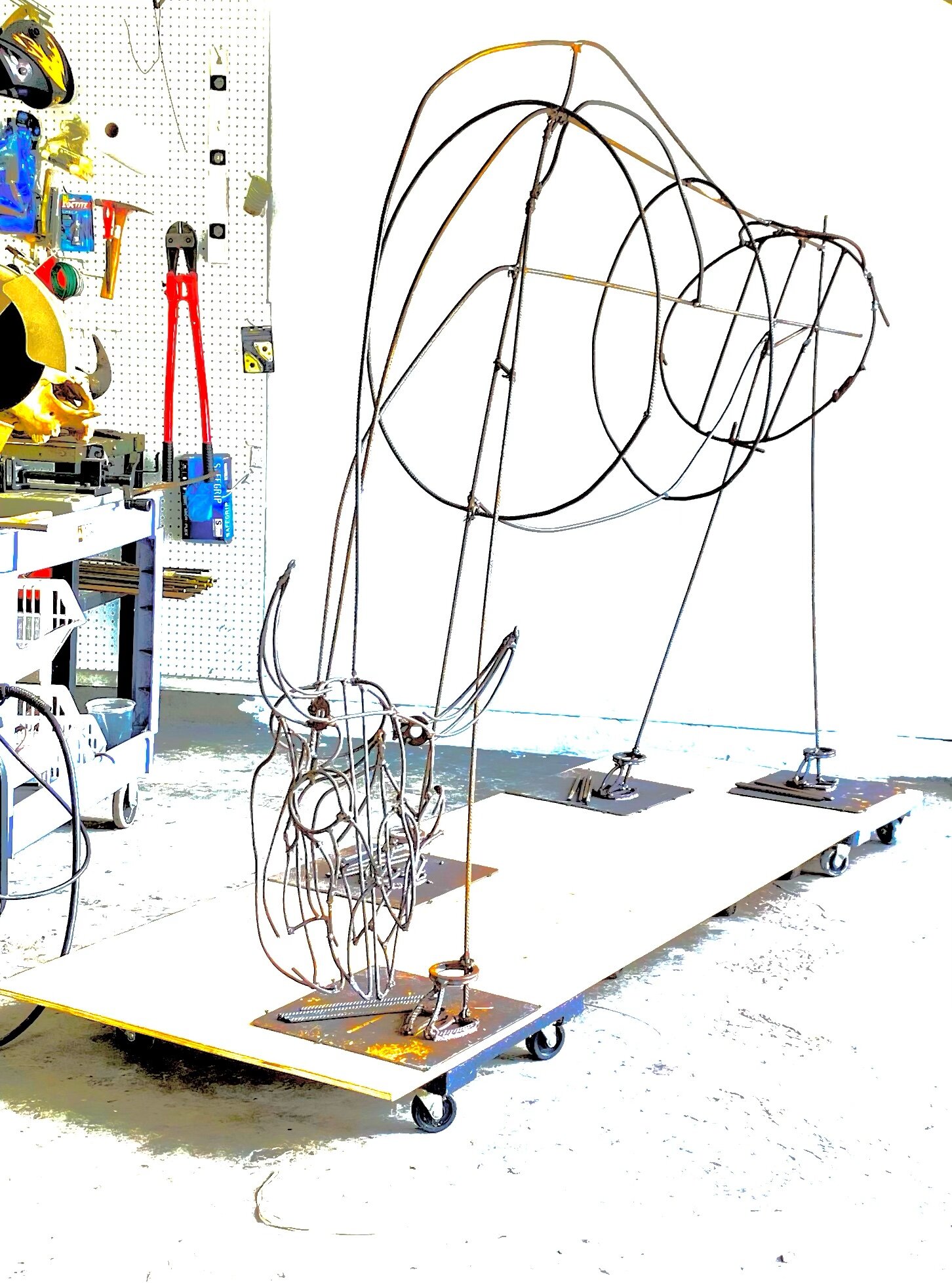
Another big day of welding..I added a big 96” circumference chest. Put the entire piece on four dollies and started his hump. Below are a few pics from todays work.

Behind my garage is a telephone pole. I use it to bend my rebar. This is a side view where I am going to bend the piece for the chest.
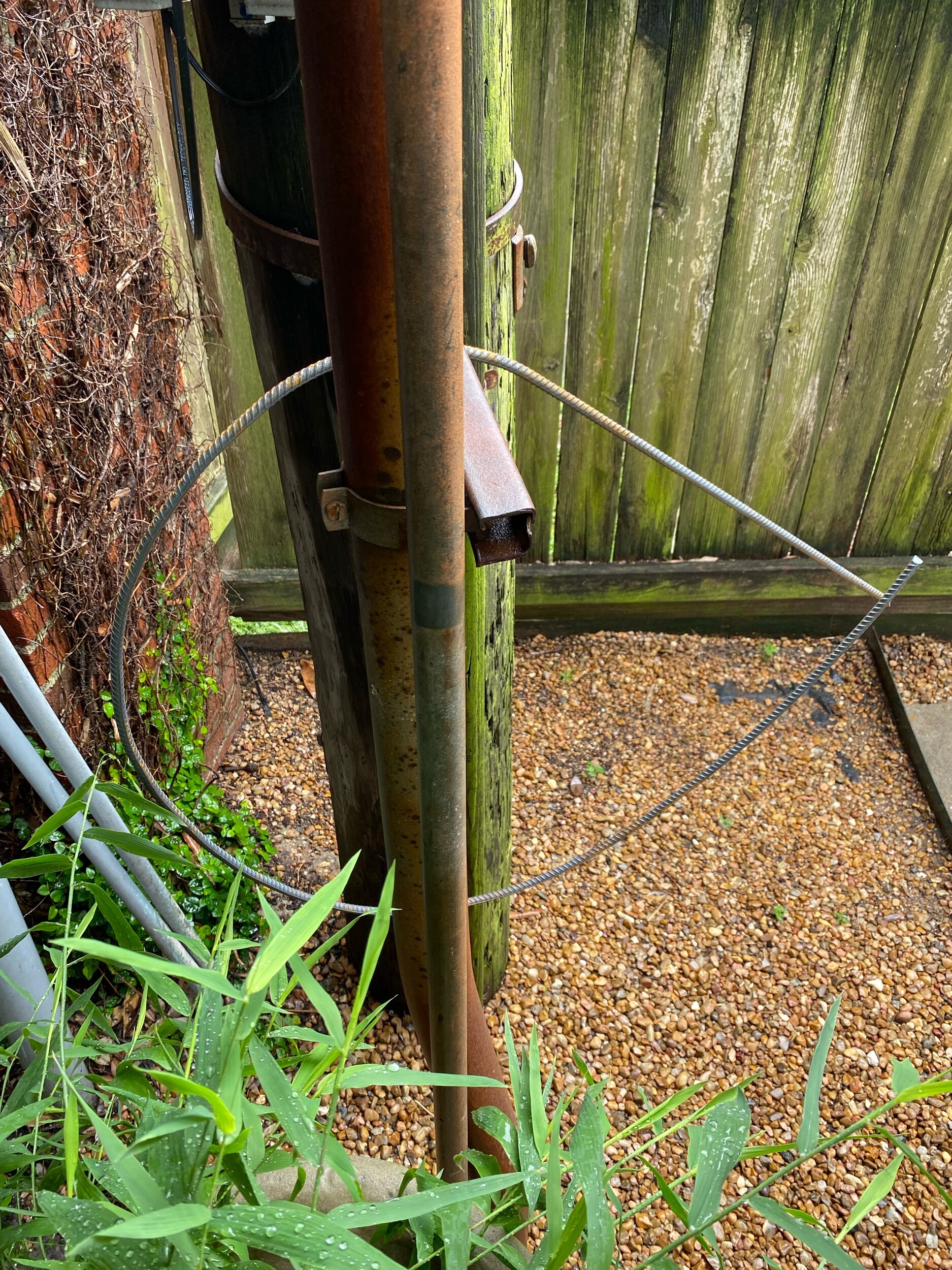
Halfway to becoming a bison chest.
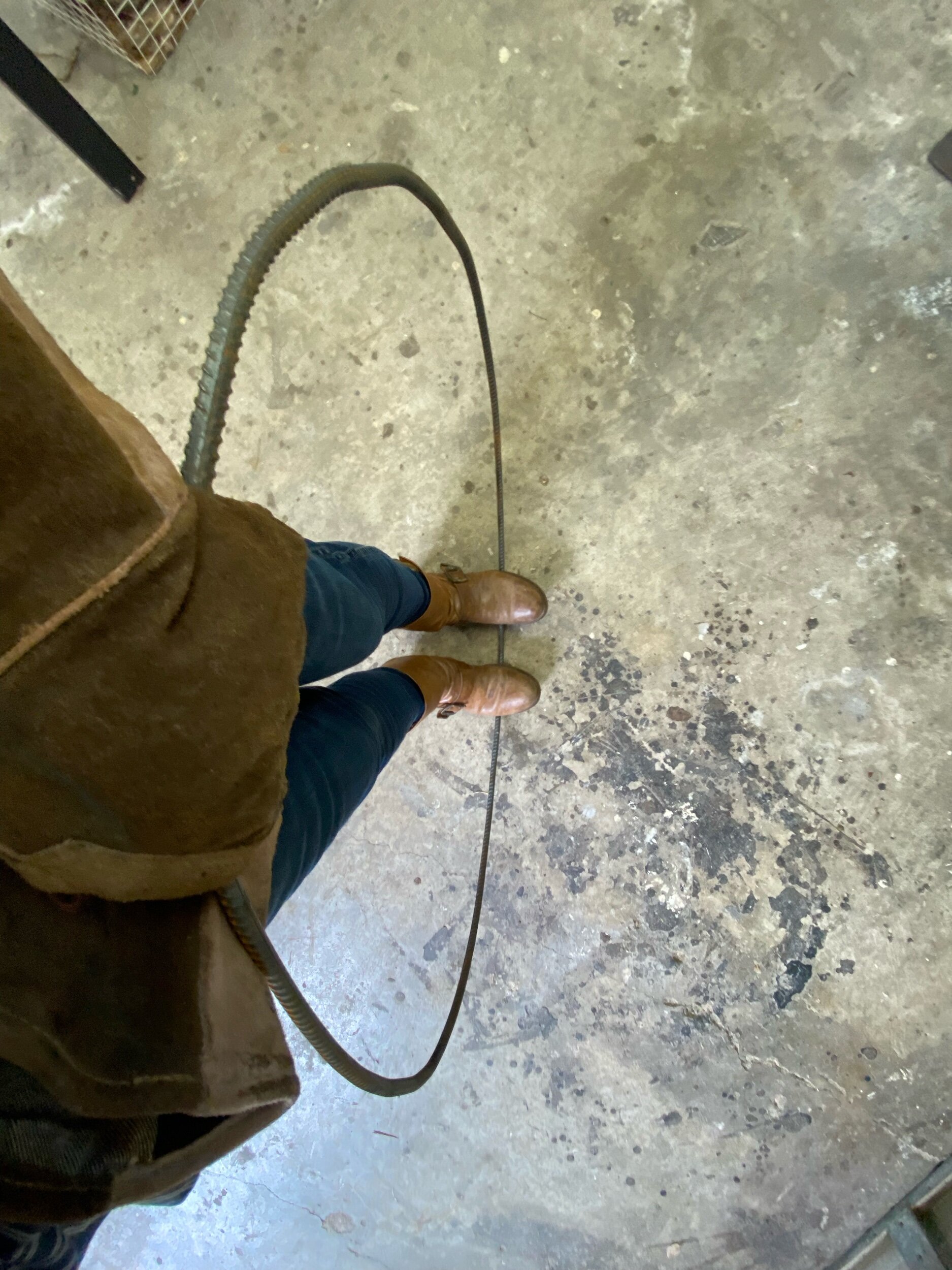
Then I use my weight to even out the shape.

I hang the chest over the back and decide if it is big enough.

Next I weld the ends together .

Recycling some old dollies from past work and deciding on the best plan. Balance and portability is the goal. The brown paper is the footprint of my bisons. Each leg is supported by a dollie.

Thanks to Curtis for getting me the plywood and helping me mount the beast. This is just for while I work on the sculpture and for transportation. It is not part of the work.

Just goofing around

My garage studio assistant is taking a sun break.
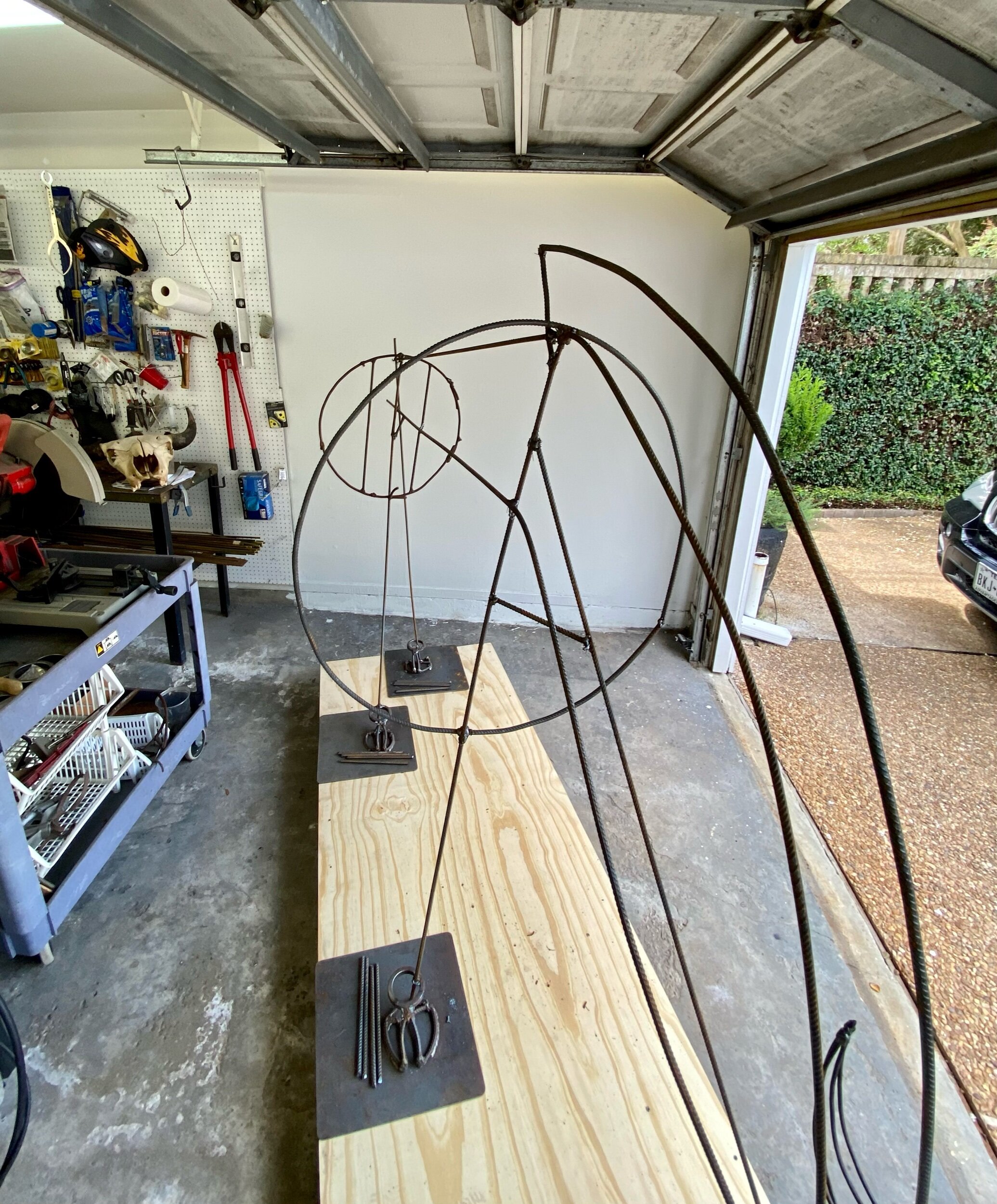
Starting to assemble the hump.

And that's a wrap.
July 5th.
Attaching the head—
I welded just one connection from the neck to the head. As I assemble other parts of his body I will continue to evaluate the position of the head. I want him to be his reaching to the side searching for the next blades of grass within the reach of his massive head and tongue. With only one weld I can easily cut it off if I decide it is not in the right place or at the right angle. I do enjoy having a bobblehead bison in my garage for a while.
Building the girt—
I happened to have a circular scrap piece of rebar almost the right size. I created it years ago to be a round seat for a faux bois chair that was started and not finished. I turned it into the basis for the bison’s rear hip girth/stomach.
It is a little small, the small size gives me the flexibility to add to it exactly where I want it to protrude. As I get more elements worked out I will make it larger by adding the back hip bones that protrude. t is a lot easier to add pieces as I build him than to cut out pieces.

1 small tack world neck to head. Just to see where I want it.
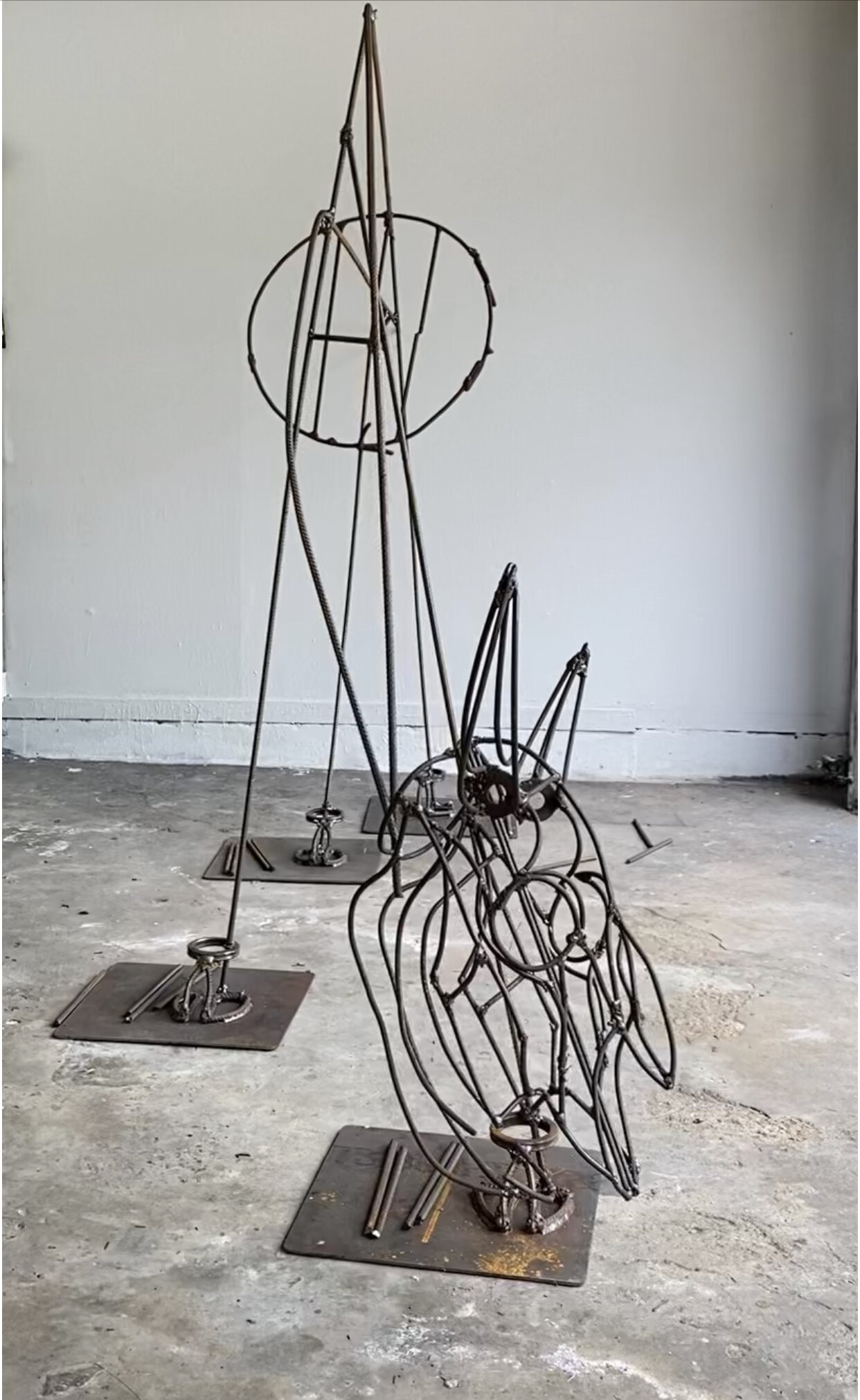

"If you want to make small changes, change how you do things;
if you want to make big changes, change how you see things."
— In Dirt to Soil, Gabe Brown
How do we restore an ecological balance in Houston? We see Houston in the global ecosystem, see our relationship with wildlife and sea life of the western hemisphere.

Houston
See — Houston can balance humanity and urban wildlife.
Site-Specific installation: Symbiosis is a micro-ecosystem in an important ecological space.
Houston is 600 square miles of mostly privately owned land inhabited by 2.3 million organisms, on the Gulf Coast of South-Eastern North America. Its rainwater runoff feeds the ocean and impacts reefs one hundred miles into the seas. Chemicals from Houston are reported killing reefs 100 miles into the Gulf.

Drain
See — The pesticides, herbicides, and fungicides used to keep Houston’s commercial, residential city and county landscapes manicured are leached by rainwaters that drain into the Gulf of Mexico from our streets.
The plants in Symbiosis do not need chemical inputs to thrive. They have evolved to withstand droughts floods and freezing temperatures.
Located near the lower apex of the triangular-shaped North American continent Houston’s land and water provide nesting, hydration, and nutrition for animals that utilize this critical migratory pathway that funnels migratory life between the northern and southern continents of the western hemisphere. More than one in four birds in the U.S. and Canada has disappeared within my lifetime. Birds play crucial roles in maintaining an ecological balance on the coastal prairie, from eating mosquitos to providing food for scavengers and decomposers.

One In Four Birds In the US Has disappeared In My Lifetime.
See — that birds play crucial roles in maintaining an ecological balance on the coastal prairie, from eating mosquitos to providing food for scavengers and decomposers.
Symbiosis is building living soil that supports bugs, beetles and insects that birds need to feed their young.
A male American Robin sits on the fence at Lawndale at the light of day June 18th, 2021 with Gulf fritillary larvae in his mouth. Until Symbiosis was installed birds flew over Lawndale. The garden was sterile of what modern civilization calls landscape pests/what birds feed their young. The sculpture garden did not offer food or habitat for birds.

Larvae of Gulf Frittilary butterfly – Detail of Symbiosis
See — An important nutrient necessary for birds young to thrive.
With native plants in our urban gardens and commercial outdoor spaces, chemical inputs are not necessary. Chemical-free yards will help bring back the 1107 species once common in the Coastal Prairie.
Houston, the site, has experienced extreme flooding and weather conditions. We are located where once was the Coastal Prairie ecosystem that sequestered Carbon like an upside-down rainforest and absorbed water like a sponge. Of that original landscape, only 1% still exists. And yet, we can see an opportunity to capitalize on Houston’s reputation as the city of energy and cultural diversity. We can mitigate global warming and extreme weather conditions by changing how we see our role in a balanced ecosystem.

Lawndale Symbiosis
Lawndale’s sculpture garden is a micro-ecosystem within an important macro-ecosystem that casts a wide net.

Symbionts
The Passiflora incarnata provides nectar for pollinators. Native bees are the original regenerative farmers, they take nectar and regenerate the flower pollinating the Passiflora incarnata.
This is one species of the 4,000 bees native to the US. (Please note this is not a honey bee. Honey bees are not native to the US. They are part of the industrial farming ecological problem.)
I see an opportunity to create the visual for environmental change. I see hope.
“Look closely at nature and you will understand everything better” - Albert Einstein
Look closely at your micro-ecosystem.
To sustain is not enough. Our civilization has depleted the Earth's soil. It is not enough to sustain a depleted planet; we must all do our part and regenerate soil health to sustain life. Regenerating the Earth’s soil is an ongoing DIY project.
ART CAN ONLY ACTIVATE CHANGE WITH YOUR ADDED PERFORMANCE
—If you care about the environment, help get the conversation going and restore an ecological balance in Houston. Post one image of Houston native plants and or wildlife on Instagram #lawndalesymbiosis and tag two friends.
In addition, forward this to two friends.
Ask two friends to do the same, and ask them to ask two more friends, building a pyramid of activism.
For an enhanced experience viewing Houston’s wildlife and landscape I recommend the citizen science apps
“iNaturalist” and “Seek”.
Symbiosis — DIY Steps
Change can happen at lightning speed when innovation is coupled with imitation. Here are the steps I took feel free to imitate them.
I became familiar with the six principles of Holistic Regenerative agriculture through the Savory Institute, Roam Ranch and was recently featured in the film Kiss the Ground. I wanted to make a difference and regenerate depleted land, too. However, a bison ranch is not in my future. It occurred to me that changing how we landscape Houston could make an ecological impact. Lawndale Art Center offered me the opportunity to install an environmental sculpture in the garden. They had just re-landscaped the sculpture garden with a traditional garden, so I did not expect them to accept my proposal. However, Lawndale is committed to artists that explore aesthetic, critical and social issues of our times. Symbiosis is a catalyst to invite the public to change Houstons’s environmental impact. Applying these principles to Houston’s greater urban landscape will significantly impact climate and extreme weather conditions. Houstonians—or anyone—can do this. Climate change is a DIY project.
Below I describe these principles as I applied them to Symbiosis.
See how others across the world have used the same principles I used below.
6 PRINCIPLES of HOLISTIC REGENERATIVE AGRICULTURE AND SYMBIOSIS
Installing this site-specific installation, I incorporated the same principles used to regenerate depleted soils worldwide.
Holistic management — BALANCE —Symbiotic
I keep in mind that the garden is a microsystem that must contribute to and function in the greater ecosystem of the western hemisphere’s continents and waters. In Symbiosis, I balance the needs of the; art institution, urban wildlife, donors, exhibiting artists, the surrounding community, and volunteers.

Holistic management — balancing the needs to run the art center, the neighboring community and urban wildlife/landscape.
Integrating livestock to build soil microbes — GroundWORK
Living soil does not come from synthetic inputs. Instead, it comes from decaying matter that completes the circle of life. Mimicking this process in an urban environment is a crucial step. Without it, there is no life. In the natural world, grazing livestock such as bison, cows, sheep, goats, or chickens provides the decaying matter through their waste, stomping it in the ground and eating and damaging vegetation.
In Symbiosis, I mimic this process by installing a native leaf compost with animal waste components. It is full of beneficial microbes, free of dangerous synthetic chemicals, toxic dyes, and sewage. The heat from composting kills the pathogens. It is safe for children and pets. Because this step is critical, I turned it into a community performance art event. — GroundWORK

Intergrading animal — GroundWORK
Native moldy leaf compost was installed during the GroundWORK event on behalf of RoXoR gin a sponsor of Lawndale’s spring 2021 fundraiser event.
Eliminating tillage — CarbonSINK
While we work to reduce greenhouse gas emissions, it is more critical to sink the Carbon in the atmosphere back into the soil. Carbon is stabile in the roots and microorganisms of plants in the ground. When soil is disturbed, Carbon is exposed to oxygen and transformed into carbon dioxide, which warms the planet. Conversely, organisms can establish communities that feed off the soil's organic matter when the earth is undisturbed. As soil organic matter improves, so does the soil’s internal structure.
A healthy soil biome is vital for suppressing plant diseases and cycling nutrients among plants, eliminating the need for synthetic inputs whose production increases our carbon footprint.
In Symbiosis, I am building a CarbonSINK by not turning the soil over before planting, keeping the soil structure intact as much as possible, and implementing “Chop and Drop” composting when plants go dormant. Symbiosis builds soil biology and increases soil structure, increasing the soil's ability to absorb Carbon and water, reducing runoff, soil erosion, flooding, and preventing pollution from entering nearby bayous.

Eliminating tillage — CarbonSINK
After a freeze in 2022, the red salvia above ground suffered. I carefully chopped all the dead materials and dropped them in the garden. I always leave the roots in the ground and 6” - 10” of stems for solitary native bees to nest in.
Maximizing crop/plant biodiversity, — ReCover
We do not know what we have lost until we recover it.
With this thought, I researched native plants and what roles they have played in the Houston area ecosystem. Identified in the Coastal Prairie are more than 1,000 plus plant species. I have not relied on hybrids/variants of species or plants considered beneficial. Instead, I selected 36 species known as indigenous to the area. Native plants have supported over 4,000 native bees, 1,107 bird species, 750 species of butterflies, 200 skippers, and 11,000 months, and 4,000 wasps.
Symbiosis is to recover and support as many of these species as possible for all four seasons. In addition to supporting wildlife, I sought out plants that helped control ground erosion and water absorption. — Plant it and they will come—

Maximizing Biodiversity — ReCover
Hyla cinerea , there are five true tree frogs in Texas. They climb grass and require a permanent water feature, a trough pond will do. I first saw tree frogs in the garden in September 2021 on a bushy Bluestem. I have since seen them on the Mealy blue sage. I have never seen a 2.5” tree frog in Houston before. I hope we can recover a few for every yard.
Plant material selections: Salvia Lyrata, Calyptocarpus vialis, Phyla nodiflora, Bouteloua gracilis, Carex peredentata, Tradescantia occidentalis, Calyophus brerland, Oenothera speciosa, Rudbeckia hirta, Ratibida columnifera, Monarda citriodora, Echinacea purpurea, Schizachyrium scoparium, Salvia coccinea, Gaillardia pulchella, Symphyotrichum patens, Salvia, Farinacea, Chasmanthium lati, Silphium gracile, Verbena xutha, Salvia azurea, Eryngium yuccifolium, Solidago sempervirens, Capsicum annuum, Callicarpa Americana, Symphoricarpos orbiculatus.
Grasses: Andropogon gerardii Vitman, Schizachyrium scoparium, Chasmanthium latifolium, Carex texensis
VINES: Lonicera sempervirens L, Gelsemium sempervirens, Wisteria frutescens, begonia capreolata, Passiflora incarnata
Keeping the soil covered — Skin = CarbonSINK + GroundWATER = GlobalCOOLING
—Skin, Like human skin the palnet’s skin provides many services necessary for good health.
The Earth’s skin is green. “The Earth is a living organism, composed of millions of species and billions of organisms—bacteria, algae, microscopic insects, earthworms, beetles, ants, mites, fungi and more—representing the greatest concentration of biomass anywhere on the planet. Microbes, which make up only one-half of one percent of the total soil mass, are the yeasts, algae, protozoa, bacteria, nematodes, and fungi that process organic matter into rich, dark, stable humus in the soil." There are more soil microorganisms in a teaspoon of healthy soil than there are people on the Earth! The living organisms in the soil receive their food and shelter from plants' biological processes and physical structure.
In Symbiosis protecting the surface of the work with green skin is an easy decision for me. The quality of the skin is intimately tied to cooling the planet through Carbon and groundwater.

Keeping the soil covered — Skin
—CarbonSINK
I installed the plant material in a manner that mimics how seeds drift in the wind and are carried by animals in their coats or deposited in their waste — resulting in multilayered vertical, horizontal, and diagonal jigsaw puzzles of leaf shapes. These shapes have evolved over thousands of years, woven together to maximize every ray of sunlight. The living material will grow into a three-dimensional solar panel from 6" to 6' tall, sequestering Carbon out of the air and storing it in the living soil. I did not leave the ground bare around each species as is popular in traditional urban landscapes.

CarbonSINK — utilizing a variety of plant shapes to maximize carbon capture.
— GroundWater
Living organisms need oxygen. When rain hits the unprotected ground, the micro spaces that allow air to penetrate the soil collapse and the living organisms die from lack of oxygen. I selected thirty-six species of plants to include various leaf sizes and shapes, stem heights, bloom sizes, and surface textures. As the plants mature, they become a multitiered water slide of twists and turns, slowing rainwater, trickling it to the ground. This allows the Earth to respond like a sponge soaking up the precipitation and channeling it through the root systems and air pockets as freshwater to the aquifer for future generations. Slowing rainwater can mitigate flooding that has become the norm in Houston.
— GlobalCOOLING: Soil soaked in water like a sponge and covered in plants that move, as a gentle breeze blows off the Gulf of Mexico, conditions and cools the air and the earth as it is warmed by the sun. In contrast moving cool rainwater across hot surfaces such as turf grass, artificial turf or concrete landscape, warms the water, picks up chemicals and dumps the urban solar-heated water full of toxic chemicals into the ocean.

GroundWater and GlobalCOOLING — multiple layers of plants slow rainwater, giving the ground time to soak it up, purify and store it in the aquifer.
Maintaining living roots year-round — FoodWEB — GlobalCOOLING
Living roots in the soil are vital for feeding the bacteria and fungi that provide food for the creatures further up the chain. Living roots keep mycorrhizal fungi alive and healthy. These symbionts are vital for nourishing plants and provide convenient fertilizer and water. Maintaining living roots in the ground feeds organisms, providing year-round carbonSINK and GlobalCOOLING.
I try to do a little everyday. I am building the armature of the body. When it is finished it will be an old male - 12’ long 6’ tall . His head will be gently reaching left of center - He will be confidently and casually grazing on a variety greens native to the Texas Prairie. His neck will be supporting his massive head as it floats over the landscape. His tongue gently wraps around the next blade of little blue stem. His left front leg following the reach of his jaws as he sorts through the green haze. Right front leg is the main support in this moment of dining. It extends slightly wide to counterbalance the pendulum movement of the rhythmic massive jaw. The back left leg the main support of the shorter, less massive back end. 🤠
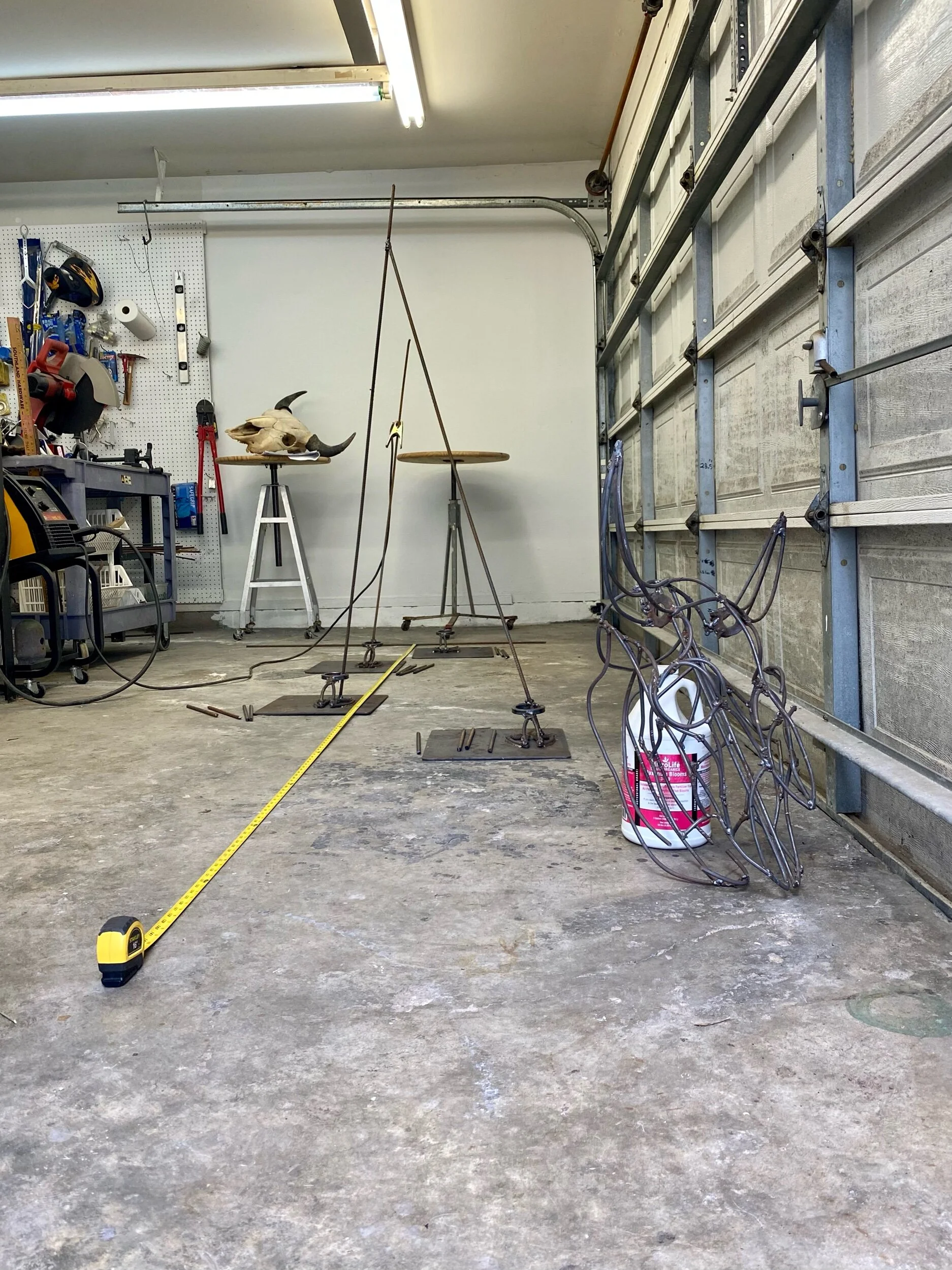
His right eye looking forward aware of his surroundings. They are prey animals. Prey animals eyes are on the side of their head.
SMH fall of 2020 was canceled due to Covid 19 last July of 2020. I put a halt on welding my piece and focused on planning “Symbiosis.” “Symbiosis” is installed the Big Show is opened which provided a tremendous amount of traffic. I will still check on it every day, but I will spend most of my day building my piece for SMH 2021. Today I started where I left off. Below are images from last year's work and blog posts.


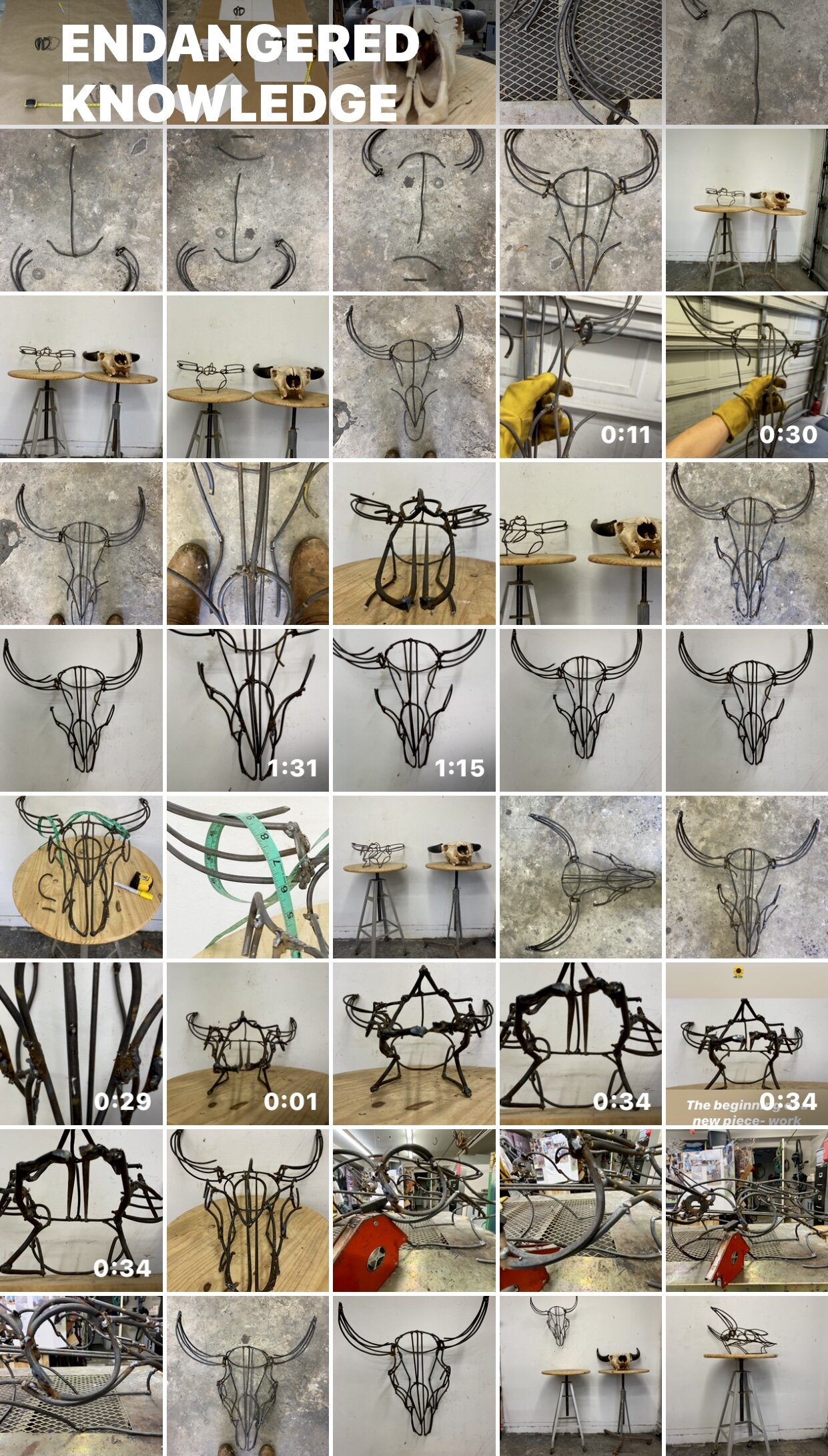

When I stopped in 2020 I had the hooves on steel plate bases and new where I wanted them to bare the weight.

Today I cut the rebar to form the lover part of the legs and grinded the tips. Tomorrow I weld.

Some of my notes from measuring Epics Bob the bison January of 2020.
My bison will be in motion not standing still.

The skull and upper jaw.

And lower jaw

4 pieces of rebar cut for each leg will provide the structure of the lower legs.
I dried some cosmos leaves to us as the coat of a sculpture that is in the works - Endangered knowledge: the Soul of Humus. The piece will be in the #sculpturemonthhouston 2021 exhibit. I started the armature during COVID for the SMH 2020 exhibit, which was postponed. The sculpture looks at the ecological history of the coastal prairie. This texture is perfect #cindeeklementart #endangeredknowledge #coastalprairie #tezasart #houstonart #bioart #environmentalart #cosmos #art #sculpture #bison
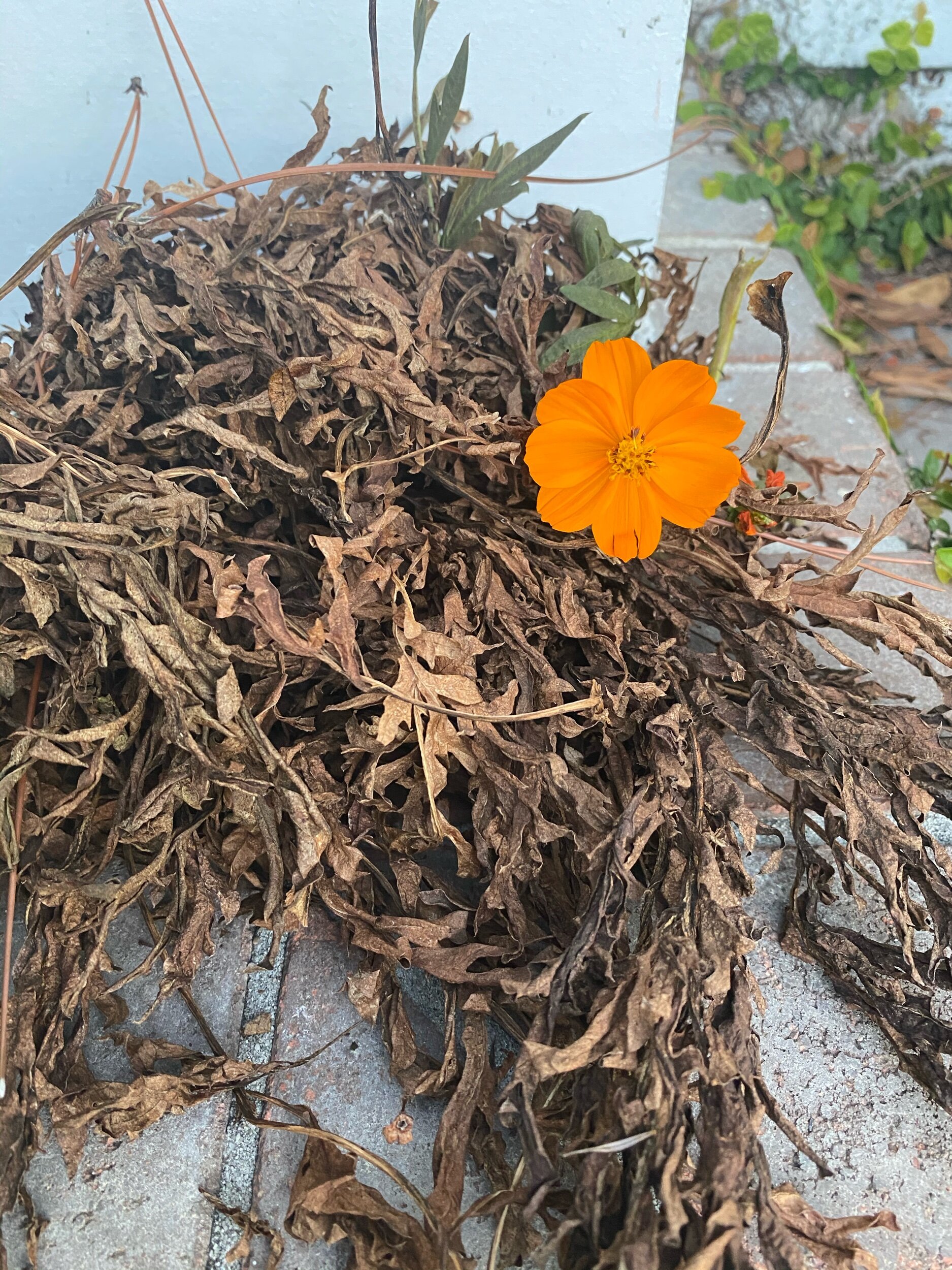
A biological memento for Same Time Next Year
Normally I do not include fleshy or soft finds. I will break that tradition with this trinket of nature. I found this larva the first week of January 2021. It is in my freezer as I write. So that I don’t have to worry about it getting thrown away, I will put it in my 2020 nest. I am hopeful that I still have the Polytgemus Moth that I collected in fall September 2919 at my studio. The two together will spark a stronger connection to appreciate and protect urban wildlife.
The sidewalks in my neighborhood are my nature trail. I walk with my eyes on the prowl for intriguing insects, exoskeletons, insect wings, feathers, dried flowers, twigs, leaves, seeds, and pods — things my children’s eyes taught me to find during our walks together over the years. Since 2013, these biological mementos have found their way into my bronze work in the molds of nests. Each piece is a reflection of that year’s ecology and records the time and movement of environmental restoration…………n Dirt to Soil, Gabe Brown quotes Don Campbell, “If you want to make small changes, change how you do things, if you want to make big changes change how you see.” When I come across intriguing flora or fauna on my urban trail, albeit few and far between, I see them as evidence that can inspire a revolution in the landscape. If they are expired and will not decompose, I collect them. I see these bronze cast nests as urban wildlife fossils—biographies, every year a chapter recording Houston's environmental awakening……….
Below m are screenshots from my seek application that I use to identify species.


A screen shot from the app seek, a wonderful app for identifying species.
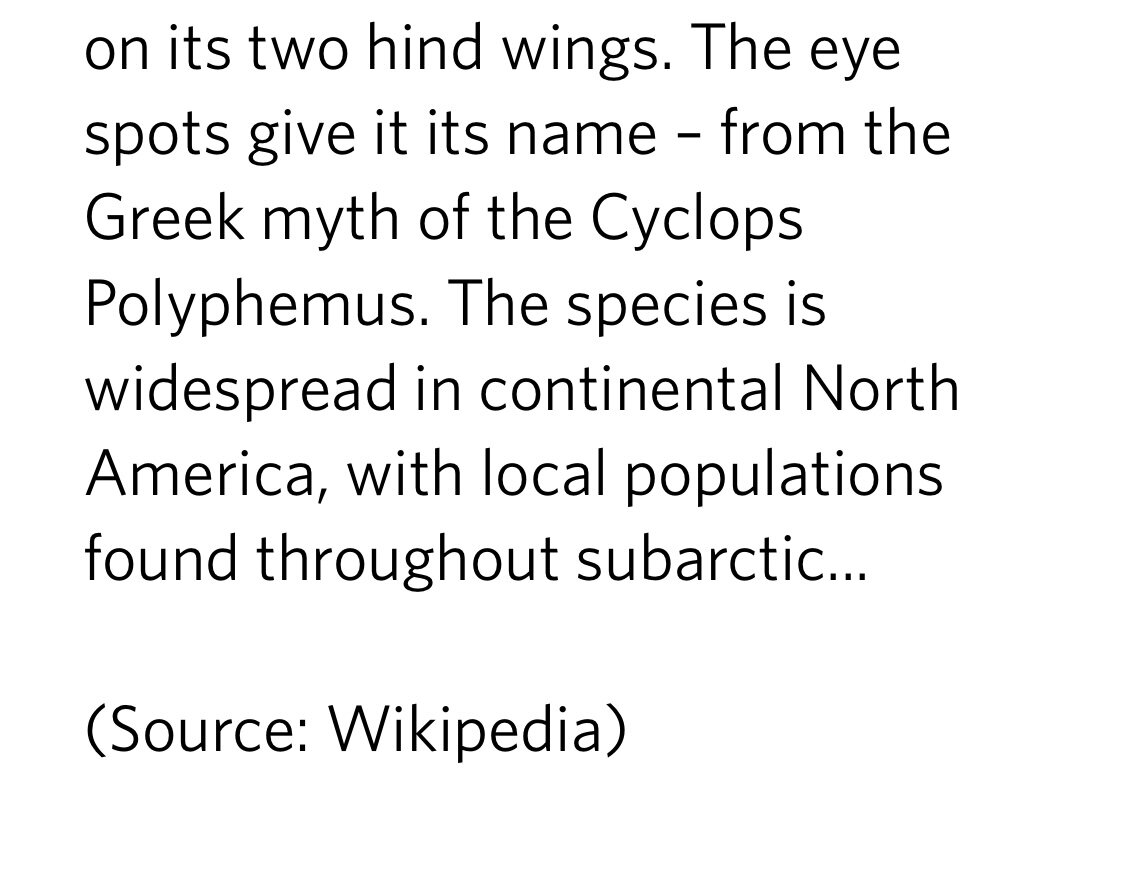



Fall 2019, I find- I think it is still in my studio in a Plastic cup.

—The last thing you see when you leave the Museum. It is worthy of bookend status to a visit to the Museum; a water feature is a holistic system study. Without a water feature, an urban garden can not be chemical-free. It is a critical component for all walks or flights of urban life. The trailer a hole, whole, and holistic is immersion art.
Read moreMierle Laderman Ukeles talks about Maintenance Art
Looking at other artist that carved a new path into the world of art, l look at Mierle Laderman. She is an inspiration an amazing woman. Maintenance art is similar to creating living soil and activating a holistic way to manage urban landscape. I offer images of some of my tools as evidence.
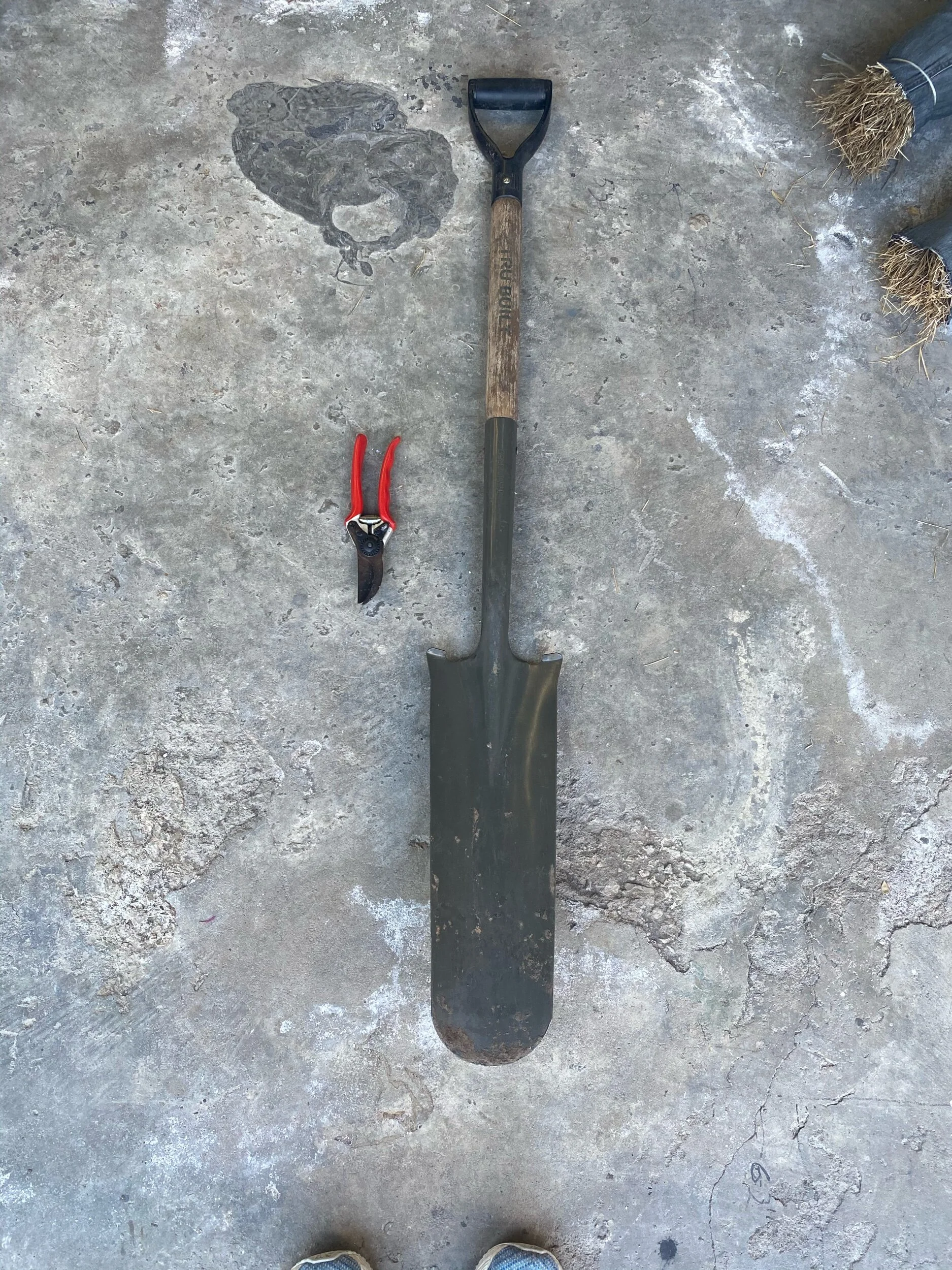
Tools for symbiosis
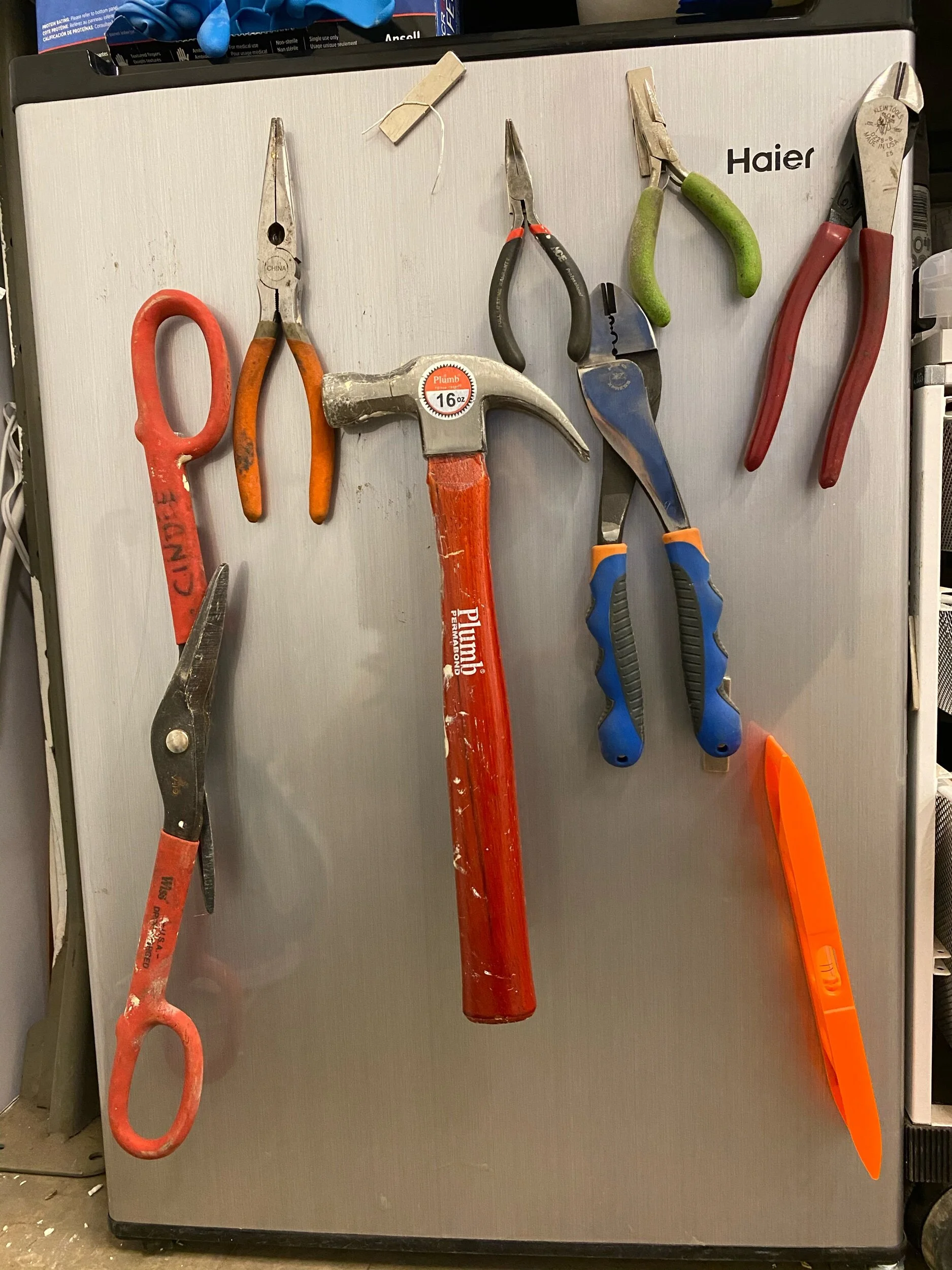
I keep some tools on my refrigerator with magnets
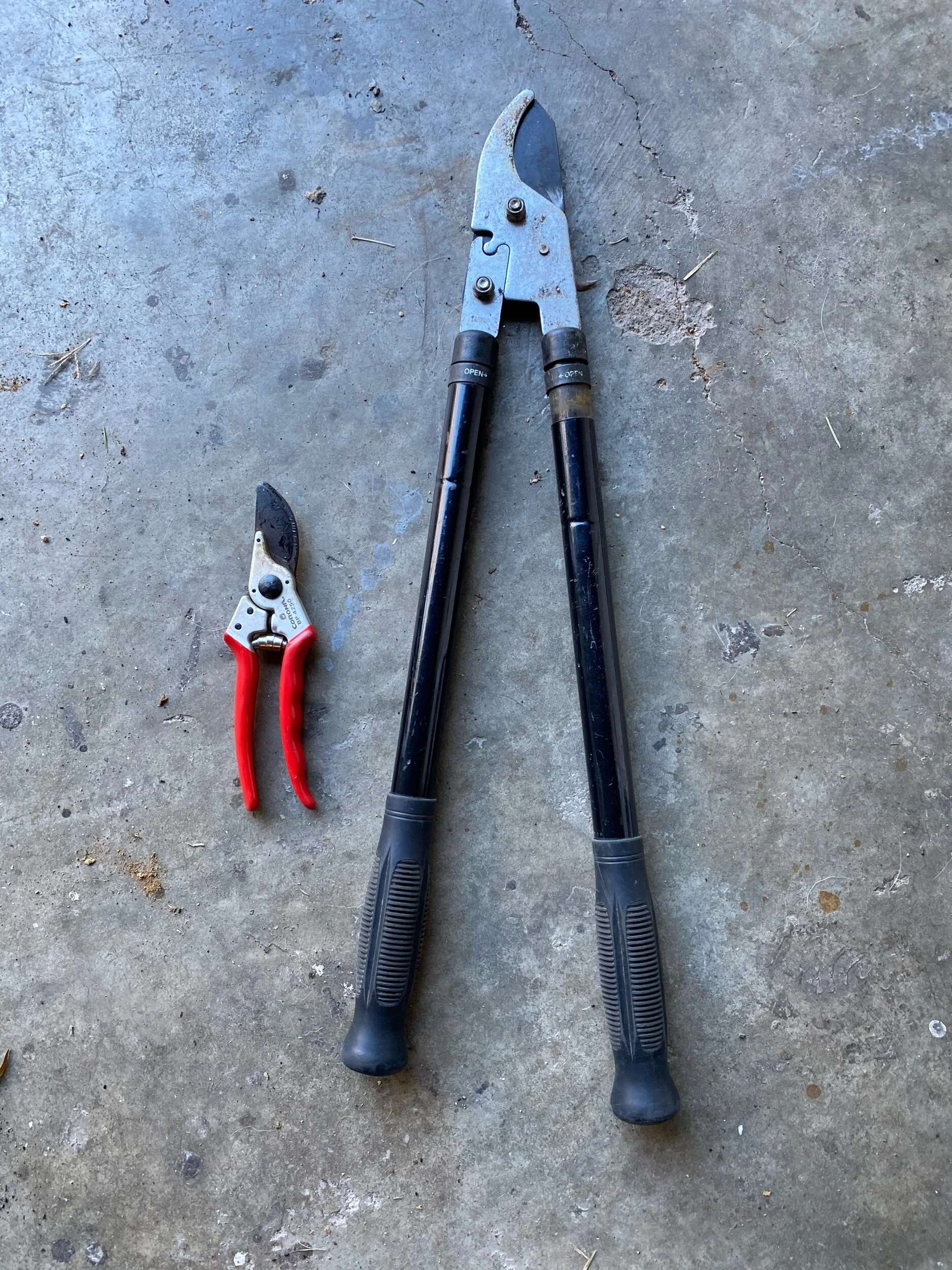
Tools for shaping Crepe Myrtles.

ROOT TO WATER
12” X 18” X 12”
found objects: rusted steel irrigation wheel, root
photo by Nash Bake

Seven immaculately bundled trimmings from a neighbors Crape, Myrtle. Crape murdered or not I- the trees were in the backyard, could not see them.

My trimmings from a site-specific installation @Lawndale Center for the Arts. Symbiosis

It took two trips
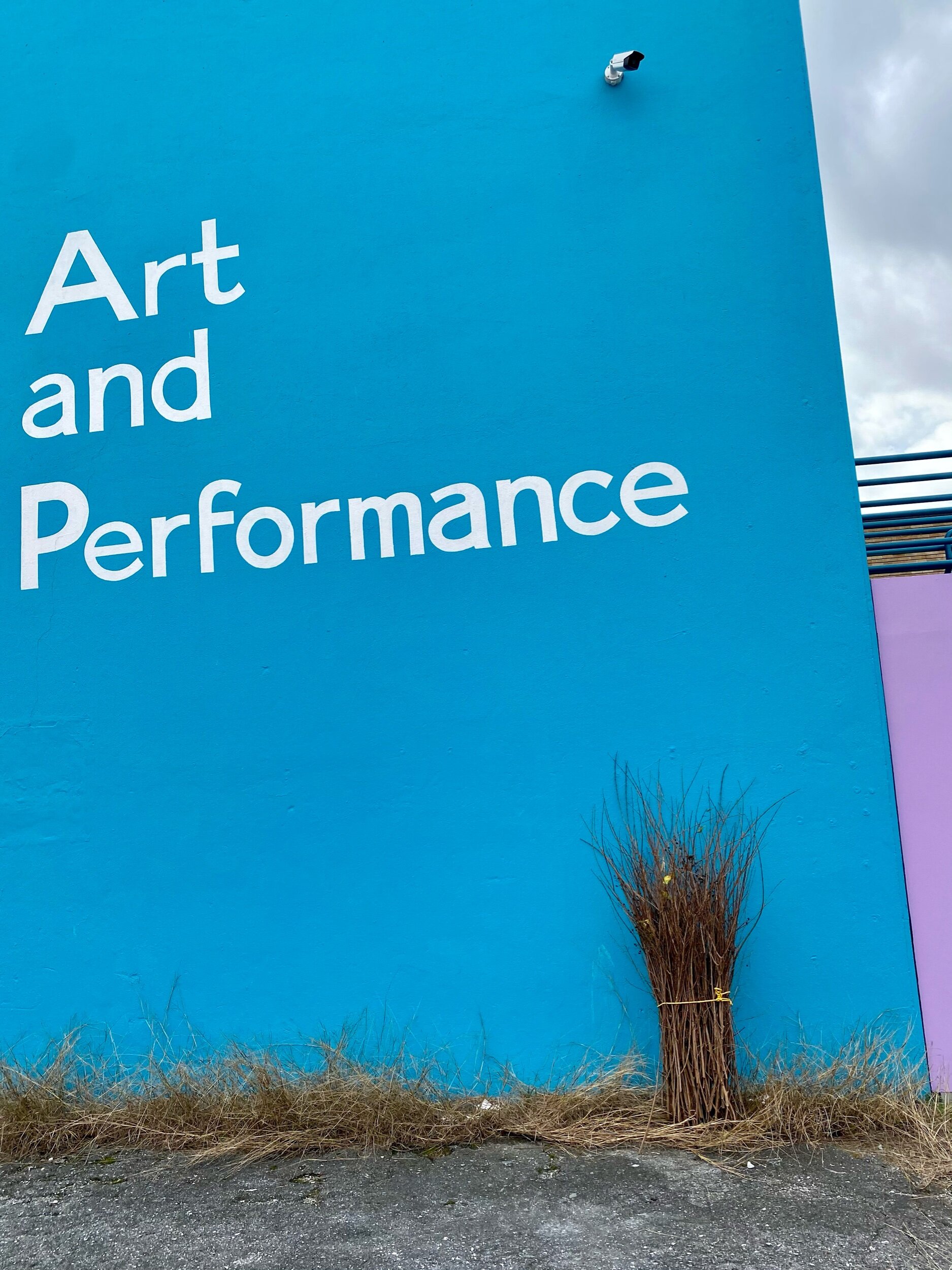
😁 when I bring new materials to Lawndale, I like to photograph them on this turquoise wall- documenting my materials. And I have to say! I love the colors - the Textures.
I declare this installation number 1. Untitled.

Installation number 2
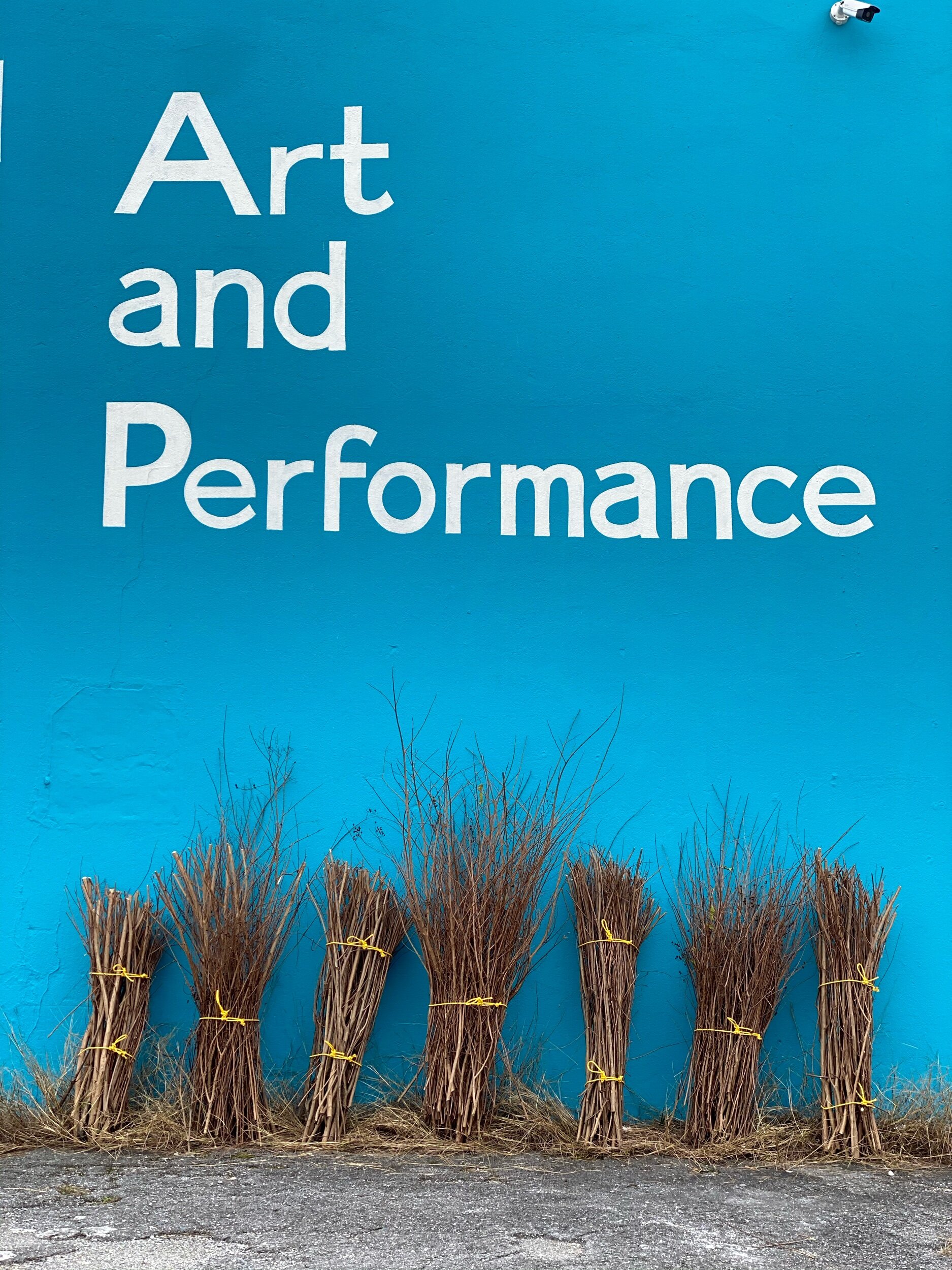
Installation number 3
The yellow ties make my heart sing, that rich brown against the turquoise, and the golden grass softening the base, I am in heaven. I see ballerinas chins up, lined up to take their bows center stage. I had one left.
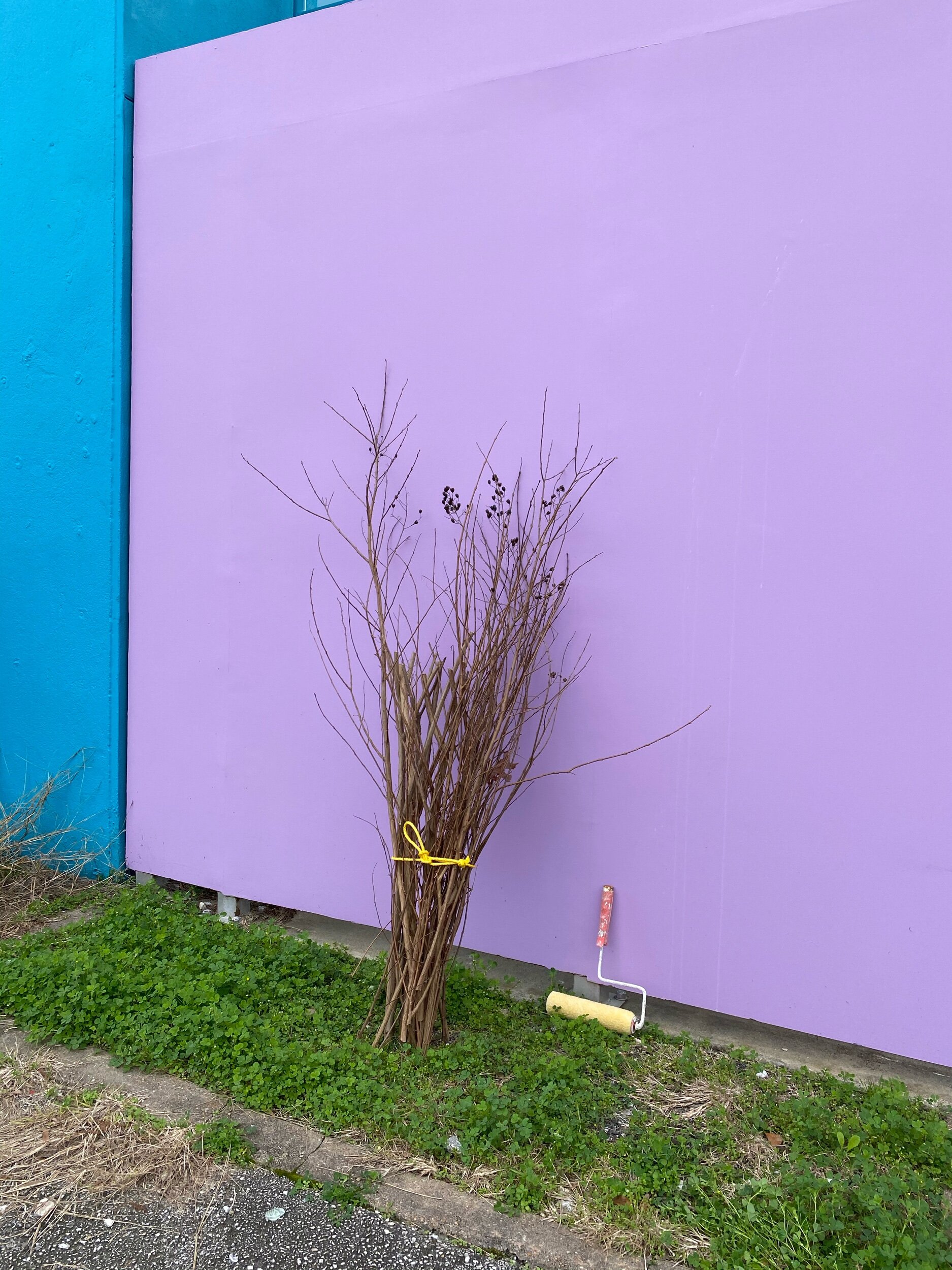
A painter from last week left their yellow roller- waste not want not. The clippings Are rich on the violet too.

Sometimes I feel guilty that I love my work so much.
Neonicotinoids disturb bumble bee and flies sleep and ability to know when to forage. It is banned in the EU and not in the US. This isn’t enough, these products used in urban gardens harm bees. Articles like these inspire me to plug on.
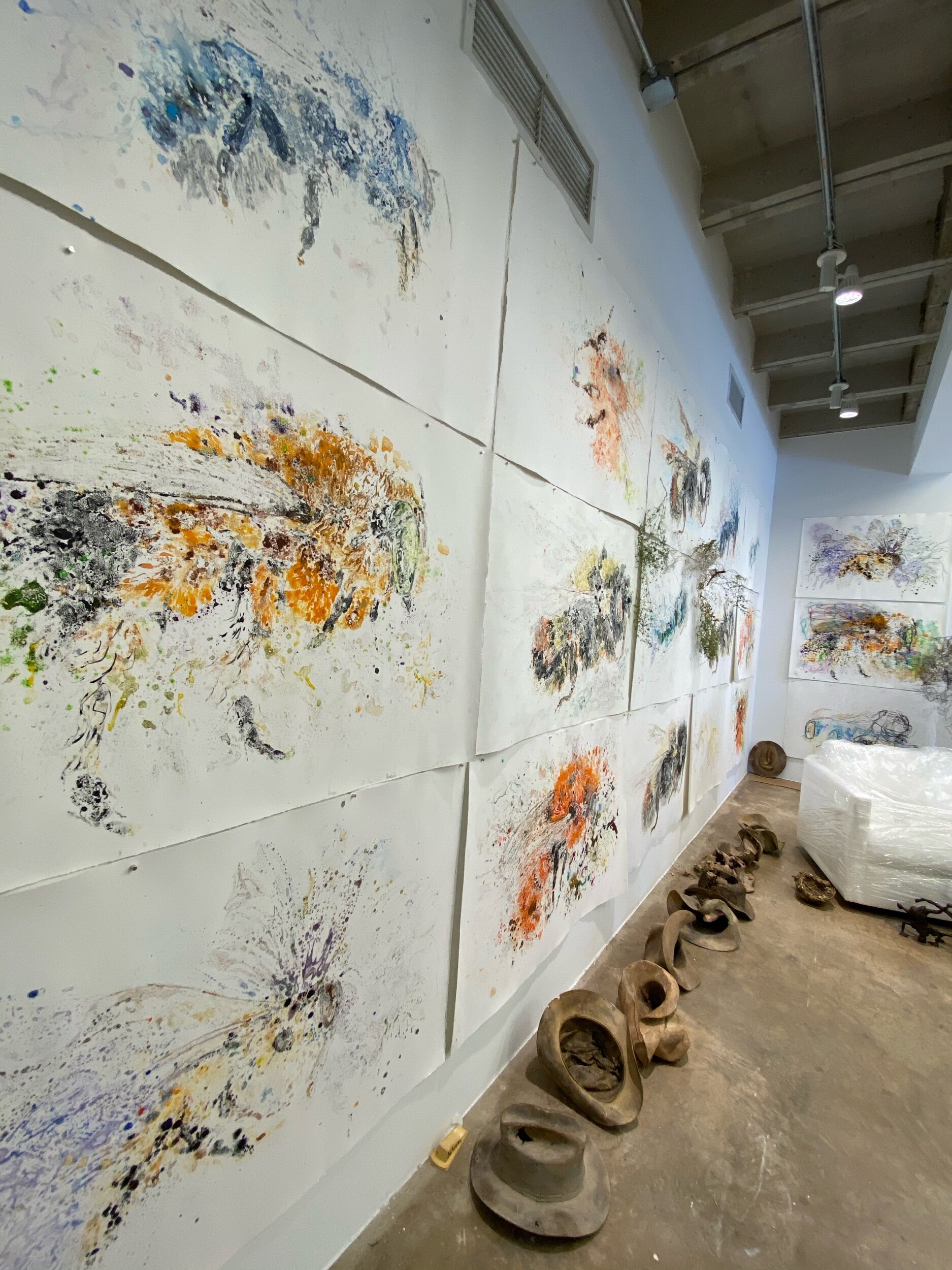
I have lost count
artist statements are also works in progress
as it sits
RUMBLINGS
Artist statement
A rumbling in the distance is nature's way to alert living creatures to their environment.
Rumblings is a work in progress, a monumental collection of fifty 30" X 44" watercolor monotypes that draw attention to the endangered knowledge of the 20,000 species of wild bees.
In these works, I carefully manipulate watercolor ink, and solvent into a chaos of infinitely miniscule paint particles. The materials are interconnected across the over-size monotypes, paralleling the synergistic, aqueous effects of the untold bee species' magnetic attraction to golden dust and their corresponding fragility due to the applied chemicals that flood residential gardens and industrial agriculture. Closely studying their exceptional ability to buzz and pollinate with their exceptional pollen-adhering bodies, I use abstraction and zoom in to depict the organized mayhem of their movements.
The installation of Rumblings inspires curiosity, alerting all viewers to pay attention, asking them to consider the unintended consequences of their actions in our-interconnected micro ecosystems. It is a resounding call to decrease pesticide usage, provide habitats for nesting, and plant native indigenous plants providing nectar for the bees that are responsible for 70% of the foods we eat.
What I do not know is when and where they will be installed, when that is in the picture I may find ways to connect the pieces visually. That will have an impact on the statement. Until the plant beautiful native plants.
After reading the document that listed Bombus Affinis as an endangered species I formed my own opinion by and it does not reflect well on the chemical industry.

Bombus Affinis - the rusty patch bumble bee
Summary from sciencedaily.com
The yield and quality of many crops benefit from pollination, but it isn't just honey bees that do this work: bumble bees also have a role. A team has used innovative molecular biological methods and traditional microscopy to investigate the pollen collecting behavior of honey bees and bumble bees in agricultural landscapes. It turns out bumble bees take much more pollen from different plant species than honey bees to satisfy their need for protein.
bumble bees are superior pollinators of tomatoes than the honey bee. The southern carpenter bee also pollinate tomatoes.
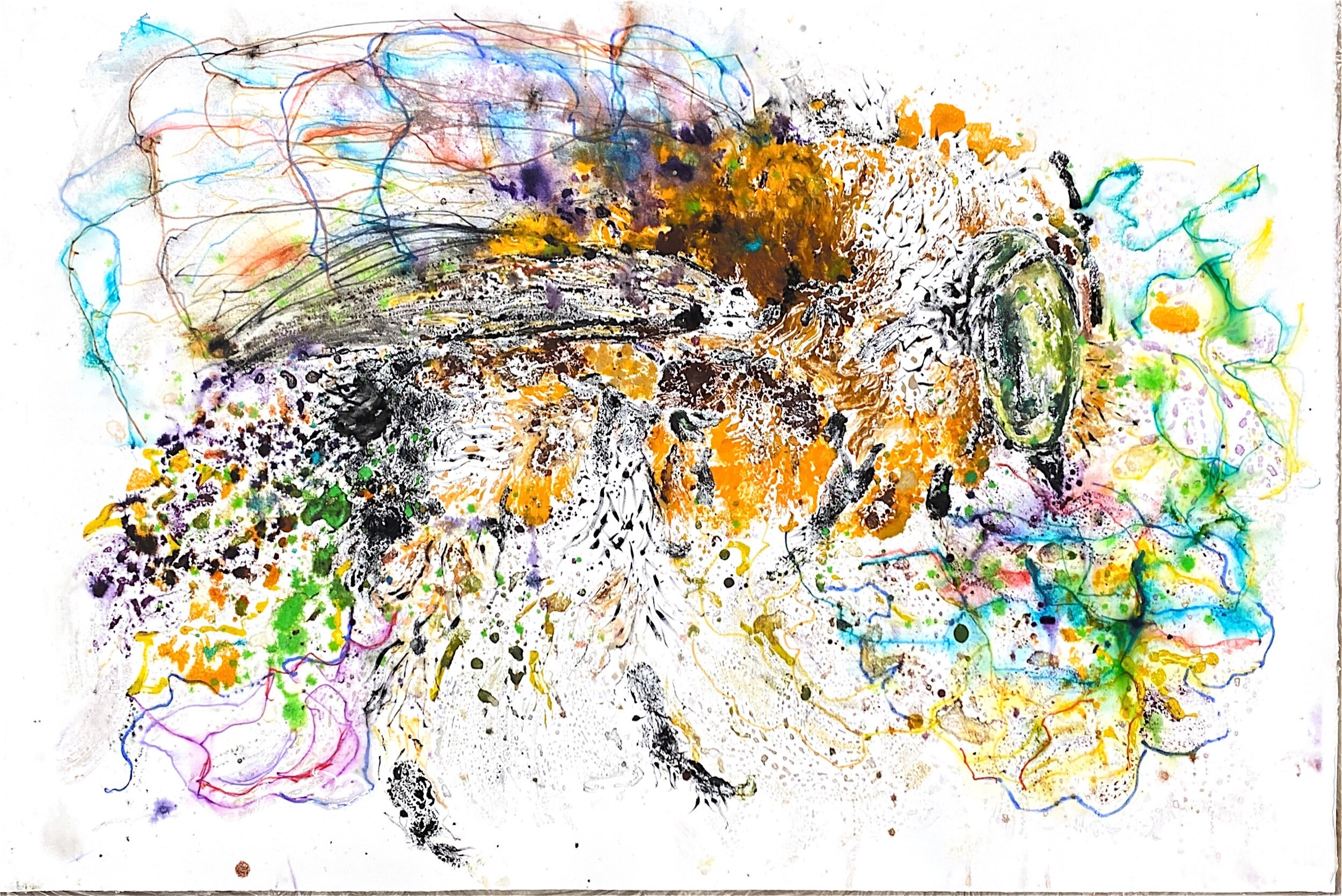


Widespread environmental change begins with envisioning (and making visible) the wisdom already inherent in the natural world. This is an inspiring example of change in the right direction. Native super Trees in the right places.
Thank you Molly Glentzer for making visible the beautifully written story Houston's newest heroes are native ‘super trees’ with special eco-powers
“Live oaks are the heaviest lifters, able to sequester 268 pounds of carbon emissions and absorb more than 2,600 gallons of flood water and 2 pounds of greenhouse gases by the time they are 10 years old. The top 12 super tree list also includes, in descending ranking, box elder, laurel oak, red maple, river birch, American elm, slipper elm, tulip tree, American sycamore, green ash, loblolly pine and white ash.” - in the words of Molly
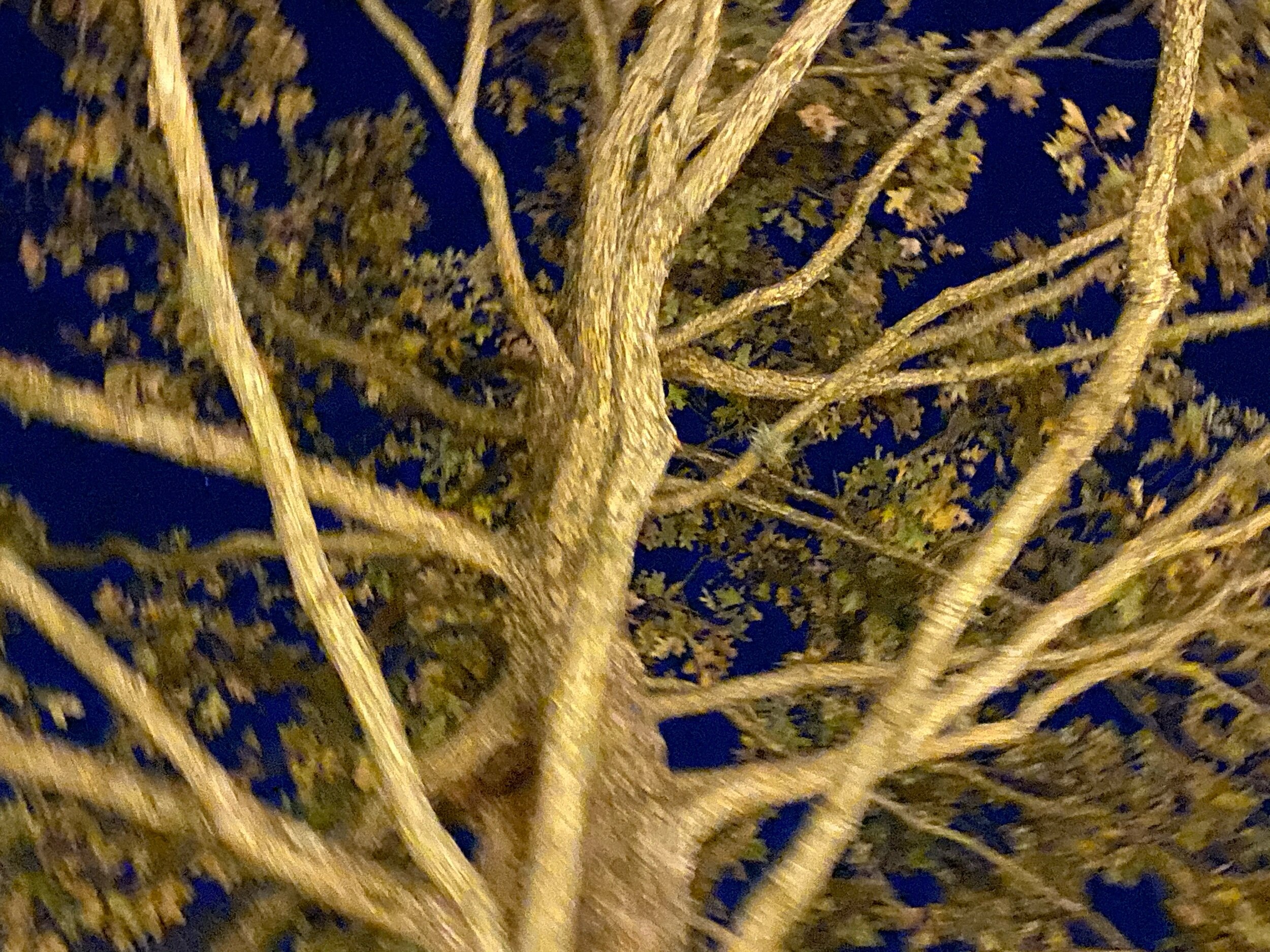
4" X 13" X 8"
bronze
photo by Nash Baker
The sidewalks in my neighborhood are my nature trail. I walk with my eyes on the prowl for intriguing insects, exoskeletons, insect wings, feathers, dried flowers, twigs, leaves, seeds, and pods — things my children’s eyes taught me to find during our walks together over the years. Since 2013, these biological mementos have found their way into my bronze work in the molds of nests. Each piece is a reflection of that year’s ecology and records the time and movement of environmental restoration.
Initially, I was unaware of the landscape around me, but as my art dove deeper into environmental restoration and Hurricane Harvey changed our city, I realized that my days are, in fact, full of sterile surfaces. With COVID-19 quarantine, children in my neighborhood started venturing outside and looking for things to capture their curiosity. Delighted with their new interest, I realized that the green spaces and puddles children explore now are no longer filled with a diversity of life; the box turtles, bullfrogs, tadpoles, bumblebees, and assortments of flitting insects have evaporated with the spray of insecticides and herbicides in our neighborhoods. The selection is reduced to cicadas, the common beetle, honeybees, a rare native bee, and an abundance of Cuban lizards that dwell in turf grasses, boxwoods, crepe myrtles and oaks. I have awakened to cultural landscape uniformity. COVID has changed how I see the need for perfect lawns; the dirty truth is mosquito home-misting machines, obsessive weed control, artificial turf and a lack of plant diversity have turned urban neighborhoods into manicured monocultures for humans exploring video games. These habitat changes in massive population centers are fast-forwarding evolution: loss of wildlife habitat is one of the biggest threats facing many animal species. This does not have to be—it is a societal choice, the ability to speed up evolution can go both ways. Through my works – Lawndale’s Symbiosis, Endangered Knowledge: The Soul of Humus, Gust, World of Hum, Rumblings and Root to Water—I am committed to creating work that educates and helps communities change how we landscape our cities to include valuing the natural world and turning back evolution.
In Dirt to Soil, Gabe Brown quotes Don Campbell, “If you want to make small changes, change how you do things, if you want to make big changes change how you see.” When I come across intriguing flora or fauna on my urban trail, albeit few and far between, I see them as evidence that can inspire a revolution in the landscape. If they are expired and will not decompose, I collect them. I see these bronze cast nests as urban wildlife fossils—biographies, every year a chapter recording Houston's environmental awakening. As an optimist—environmental—art—activist my work focuses on revealing endangered knowledge to change how we see urban landscapes and activate cooling the planet through our cityscapes. As migratory birds return year after year to build nests and raise their young, I return with optimism in my step. I envision witnessing the return of four hundred plus butterfly species and eight hundred bee species native to Texas. I can see this returned wildlife capturing my future grandkids' imaginations. I will tell them the story of how insects almost disappeared and how every yard is a micro-ecosystem and matters. I imagine their hands building nests with a diversity that I cannot imagine. I hear their voices telling me in one breath about the fuzziest-biggest bee they ever saw, covered in golden dust nesting in a patch of ground beneath the sunflowers not far from the silverleaf nightshade. I see them bringing me a tail-feather from a Red Shoulder Hawk and asking, "what does it hunt" and is it the bird that sounds like the squirrel's screech. After a rain, I see them finding two bullfrogs attached and their tiny ribbons of floating eggs in a pond. I hear them tell me not to touch the caterpillar of the southern flannel moth, and asking me, “how does it sting?”. At the low of evening when dragonflies hover; I will watch as they study the night heron’s quiet solitary stance as it stalks small citizens of the grass, I will smile as they question the raucous warnings of ravens and the scoldings of nut collecting squirrels. I will feel their excitement when neighborhood raccoons appear from storm sewers and scavenge treats from dog bowls and opossums waddle fence lines, searching out grubs and open garage doors. I will follow their eyes when the silent patrol of the lone coyote visits the shadows of our boulevards from their bayou bound dens. I let them sleep outside and hear their heavy eyelids ask, why do the owls ask who? I listen as they wake up to a concert of white-winged doves. I will feel peace when they are wise to nature.

Incorporating movement in my sculptures and print making requires researching movement. Why butterflies have such large wings in respect to their body size and how they flutter or clap is the kind of thing that interest me for future projects.
